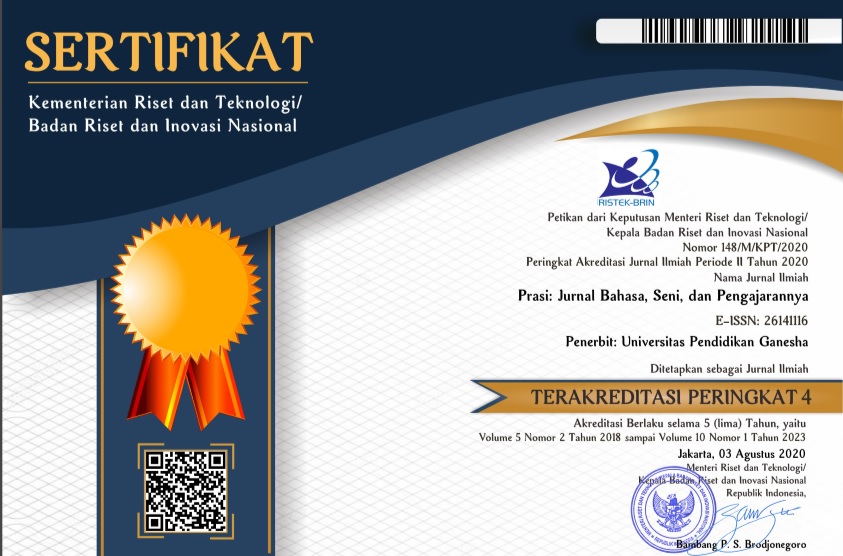THE GRAND HIGH WITCH’S CHARACTERIZATION IN ROALD DAHL’S THE WITCHES
DOI:
https://doi.org/10.23887/prasi.v19i01.70150Keywords:
Characterization, main character, novel, Roald DahlAbstract
Roald Dahl’s children’s literature usually depicts children as the protagonist and the grown-ups as the antagonist. This study aims to describe The Grand High Witch’s character as the main antagonist in Roald Dahl’s The Witches (1983). This study employs interactive qualitative analysis by Miles, Huberman and Saldaña which has 3 simultaneous processes; data condensation, data display and conclusion drawing/verifying. These 3 processes are conducted simultaneously in an interactive process which means these processes will be carried repeatedly. In the novel, The Grand High Witch was portrayed as having a scary face which she covered with a mask in order to be beautiful and accepted in society. The Grand High Witch’s cruel and cunning natures were influenced by her hatred towards children. She was portrayed as an antagonist character because her hatred led her to do bad things. Then society will construct a mindset that people only can be a bad person or kind person. Whereas, people are born with multidimensional characters. Thus, these characters could provide insight to children that people in society come with various kinds of traits.
References
Anggraeni, E. (2016). Patriarchal Practices in Roald Dahl. Universitas Diponegoro.
Bilalia, P. (2018). Psychological Analysis on the Main Character Personality in The Short Stories by Roald Dahl. British, 7(2), 99–109. http://dx.doi.org/10.31314/british.7.2.99-109.2018a
Bordwell, D., Thompson, K., & Smith, J. (2017). Film Art: Creativity, Technology, and Business. In Film Art: An Introduction (11th ed.). McGraw Hill.
Charvátová, V. (2016). Slaughter and Animal Cruelty in Roald Dahl’s Works. Masaryk University.
Curtis, J. M. (2014). “We Have a Great Task Ahead of Us!”: Child-Hate in Roald Dahl’s The Witches. Children’s Literature in Education, 45(2), 166–177. https://doi.org/10.1007/s10583-013-9207-6
Dahl, R. (1983). The Witches. Jonathan Cape.
Dewi, G. A. K., Jendra, I. M. I. I., & Sulatra, I. K. (2022). Feminism is portrayed in the main character of the movie Maleficent 2 Mistress of Evil. Elysian (English Literature, Linguistics, and Translation Studies) Journal, 2(2), 1–10.
Dewi, K. R., Suwastini, N. K. A., Supir, I. K., & Utami, I. A. M. I. (2022). The characterizations of Merida in Disney’s 2012 Brave. Dharmasmrti, 22(2), 136–145.
Dewi, N. K. J. (2022). An Analysis of Speech Acts Used in The Witches Novel by Roald Dahl. Jurnal Penelitian Mahasiswa Indonesia, 22, 91–98.
Fitria, T. N. (2021). Characterization Analysis of the Main Character in the “Hichki” Movie. Vivid: Journal of Language and Literature, 10(1), 6–17. https://doi.org/10.25077/vj.10.1.6-17.2021
Garini, B. H. A., & Winarti. (2021). The Representation of Woman as Femme Fatale in Roald Dahl’s Lamb to the Slaughter. Frasa: English Literature and Education Journal, 2(1), 15–21. https://doi.org/https://doi.org/10.47701/frasa.v2i1.2043
Gill, R. (1995). Mastering English literature (Second Edi). Palgrave.
Giovani, W., Marbun, R., & Rosnija, E. (2014). The Moral Values in the Children’s Book Entitled “Charlie and the Chocolate Factory” by Roald Dahl. 3(6), 1–20. http://dx.doi.org/10.26418/jppk.v3i6.6131
Hadju, A. V. P. (2018). Kecenderungan Kecemasan Neurotik Willy Wonka dalam novel Charlie and the Chocolate Factory Karya Roald Dahl. Madah: Jurnal Bahasa Dan Sastra, 9(1), 73–84. https://doi.org/10.31503/madah.v9i1.701
Hissan, W. S. M. (2012). An analysis of the children’s characters in Roald Dahl’s novel: Charlie and the Chocolate Factory. Indonesian Journal of Applied Linguistics, 2(1), 83–92. https://doi.org/10.17509/ijal.v2i1.107
Huan, E. (2020a). BFG: A novel written by Roald Dahl How to deal with the characterization in teaching prose. Jurnal Lazuardi, 3(2), 626–636. https://ejurnal-pendidikanbahasaundana.com/index.php/lazuardijournal/article/view/46
Huan, E. (2020b). Word Formation Procees of the Giants’ Names in the BFG - A Children's Book Written By Roal Dahl. Jurnal Lazuardi, 3(3), 626–636. https://doi.org/10.53441/jl.vol3.iss3.46
Jaber, M. H. (2016). The Female Avenger: Violence, Absurdity, and Black Humour in Roald Dahl’s Short stories. Journal of College of Education for Women, 27(3), 1170–1183.
Juliadilla, R., & Noveni, N. A. (2021). Are Childhood Cruelty to Animals Indicate Mental Disorder. Psychosophia: Journal of Psychology, Religion, and Humanity, 3(1), 56–72. https://doi.org/10.32923/psc.v3i1.1748
Julietta, A. B. B. D. (2020). The Representation of Feminist Ideology in The Characterization of Maleficent in Disney’s Maleficent (2014) From the Perspective of Ecofeminism. Universitas Pendidikan Ganesha.
Kadizade, E. D., & Karaz, B. (2021). Examining the Violence Elements in the Children’s Books of Roald Dahl. Eurasian Journal of Educational Research, 93, 95–114. https://doi.org/10.14689/ejer.2021.93.5
Maynard, L. A. (2019). The true heir of Jane Eyre: Roald Dahl’s Matilda Wormwood. CEA Critic, 81(1), 42–50. https://doi.org/10.1353/cea.2019.0007
Miles, M. B., Huberman, A. M., & Saldana, J. (2014). Qualitative data analysis: A methods sourcebook (H. Salmon, K. Perry, K. Koscielak, & L. Barret, Eds.; 3rd ed.). SAGE Publications.
Mota-Rojas, D., Monsalve, S., Lezama-García, K., Mora-Medina, P., Domínguez-Oliva, A., Ramírez-Necoechea, R., & Garcia, R. de C. M. (2022). Animal Abuse as an Indicator of Domestic Violence: One Health, One Welfare Approach. In Animals (Vol. 12, Issue 8),. MDPI. https://doi.org/10.3390/ani12080977
Murtiningrum, A., Praptawati, D., & Permatasari, R. (2023). The cultural construction of the feminine through Disney films. EduLite: Journal of English Education, Literature and Culture, 8(1), 21–33. https://doi.org/10.30659/e.8.1.21-32
Nahdiyati, A. (2009). An Analysis of Liberal Feminism Values of the Main Character in the Film “Miss Potter.” State Islamic University Syarif Hidayatullah.
Pangestu, G. (2019). Psychopatic Disorder in Roald Dahl’s The Landlady. Universitas Diponegoro.
Pradani, N. N. (2016). The Ideology in Brave Film Through Representation of Princess Merida.
Putri, R. R., & Retnaningdyah, P. (2018). Matilda’s literacy practices in Roald Dahl’s “Matilda.” 2nd Social Sciences, Humanities, and Education Conferences, 222 (SoSHEC), 187–190. https://doi.org/10.2991/soshec-18.2018.40
Rizal, M. (2017). A Film Adaptation on Characterization of Main Characters from the Lauren Kate’s Fallen. Universitas Islam Negeri Maulana Malik Ibrahim.
Saraswati, I. G. A. D. G., Suwastini, N. K. A., Utami, I. A. M. I., Jayantini, I. G. A. S. R., & Budiarta, I. W. (2021). The Representation of Character Education in the Characterizations of Lily Owens in Sue Monk Kidd’s The Secret Life of Bees. Proceedings of the 4th International Conference on Innovative Research Across Disciplines (ICIRAD 2021), 613 (Icirad), 292–302. https://doi.org/10.2991/assehr.k.211222.047
Stauri, K. E. (2020). Gender politics in Roald Dahl’s The Witches. Norwegian University of Science and Technology.
Suwastini, N. K. A., Dewi, N. K. J., Saputra, N. P. H., & Myartawan, I. P. N. W. (2022). A mouse’s courage: The characterizations of the boy in Roald Dahl’s The Witches. Yavana Bhasha : Journal of English Language Education, 5(2), 118–131. https://doi.org/10.25078/yb.v5i2.1046
Suwastini, N. K. A., Setyadewi, N. P. D., Saputra, I. N. P. H., Artini, N. N., & Mahardika, I. G. N. A. W. (2022). Maleficent as an Affectionate Fey in Disney’s 2019 Maleficent: Mistress of Evil. Humanika, 29(2), 231–248.
Tanto, T. (2020). Roald Dahl’s Ingenious Language Play in the Use of Figurative Language. International Journal of Humanity Studies (IJHS), 3(2), 201–210. https://doi.org/10.24071/ijhs.v3i2.2156
Tanusy, J. (2018). Feminism in Roald Dahl’s Lamb to the Slaughter. Advances in Social Science, Education, and Humanities Research, 166, 159–163.
Tanusy, J. (2020). Racism in Roald Dahl’s The BFG: A Social Criticism or White Supremacy Tendency? Kata, 22(2), 63–69.
Tso, A. W. B. (2012). Representations of the Monstrous-Feminine in Selected Works of C. S. Lewis, Roald Dahl and Philip Pullman. Libri et Liberi, 1(2), 215–234. https://doi.org/10.21066/carcl.libri.2012-01(02).0041
Wen, A. (2009). Penelope, Queen of Ithaca: A study of female power and worth in the Homeric society [Magister thesis]. University of Uppsala.
Wulandari, D. D. (2014). Character analysis of Snow White in the film Snow White and the Huntsman. UIN Syarif Hidayatullah.
Yasamahadewi, P., Agustina, L. W., Suwastini, N. K. A., Umbas, R., Susanthi, I. G. A. A. D., & Asril, N. M. (2021). Why Should Students Like to Have Severus Snape as a Teacher? Proceedings of the 4th International Conference on Innovative Research Across Disciplines (ICIRAD 2021), 613, 303–310. https://doi.org/10.2991/assehr.k.211222.048
Yeni, M., & Ariska, S. (2018). Children’s revenge on the bullying adults in Roald Dahl’s children’s literature. Proceeding of the 13th International Conference on Malaysia-Indonesia Relations (PAHMI), 173, 164–171. https://doi.org/https://doi.org/10.2478/9783110680003-031
Þórðardóttir, M. (2019). “The Tiniest Mite Packs the Mightiest Sting”: Interpretations of Feminism in the Works of Roald Dahl (Issue May). University of Iceland.
Downloads
Published
Issue
Section
License
Copyright (c) 2024 Ni Komang Arie Suwastini, Ida Ayu Made Istri Utami, Ni Wayan Nita Paramita

This work is licensed under a Creative Commons Attribution-ShareAlike 4.0 International License.
Authors who publish with Prasi agree to the following terms:- Authors retain copyright and grant the journal the right of first publication with the work simultaneously licensed under a Creative Commons Attribution License (CC BY-SA 4.0) that allows others to share the work with an acknowledgment of the work's authorship and initial publication in this journal
- Authors are able to enter into separate, additional contractual arrangements for the non-exclusive distribution of the journal's published version of the work (e.g., post it to an institutional repository or publish it in a book), with an acknowledgment of its initial publication in this journal.
- Authors are permitted and encouraged to post their work online (e.g., in institutional repositories or on their website) prior to and during the submission process, as it can lead to productive exchanges, as well as earlier and greater citation of published work. (See The Effect of Open Access)


.png)
.png)









